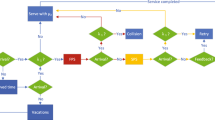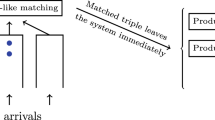Abstract
We consider two servers (serveri, i=1, 2) in tandem for which the order of servers can be changed. Server 1 has a general service time distribution and server 2 has either its ‘shifted’ or ‘truncated’ distribution. This permits that the service times at the two servers are overlapping. An unlimited queue is allowed in front of the first server. For the systems having zero buffer capacity between the servers, we show that the sojourn time of every customer is stochastically minimized under any arrival process if server 2 is first. For the systems with infinite buffer capacity and a Poisson arrivals, we show that this order of servers minimizes mean customer delay when traffic is light. Several numerical examples are presented to demonstrate that this optimal order is invariant under any arrival process (the interarrival times are i.i.d. r.v.'s) and mild traffic condition.
Similar content being viewed by others
References
Chao, X., Pinedo, M. and Sigman, K. (1989). On the interchangeability and stochastic ordering of exponential queues in tandem with blocking,Probability in the Engineering and Information Sciences,3, 223–236.
Dattatreya, E. S. (1978). Tandem queueing systems with blocking, Ph.D. Dissertation, Industrial Engineering and Operations Research, University of California, Berkeley.
Ding, J. and Greenberg, B. S. (1991a). Bowl shapes are better with buffers—sometimes,Probability in the Engineering and Informational Sciences,5, 159–169.
Ding, J. and Greenberg, B. S. (1991b). Optimal order for servers in series with no queue capacity,Probability in the Engineering and Informational Sciences,5, 449–461.
Friedman, H. D. (1965). Reduction methods for tandem queueing systems,Oper. Res.,13, 121–131.
Greenberg, B. S. and Wolff, R. W. (1988). Optimal order of servers for tandem queues in light traffic,Management Sci.,34, 500–508.
Kawashima, T. (1975). Reverse ordering of services in tandem queues,Memoirs of the Defense Academy Japan,XV, 151–159.
Miyazawa, M. (1990). Complementary generating functions for theM X/GI/1/κ andGI/M Y/1/κ queues and their application to the comparison of loss probabilities,J. Appl. Probabl.,27, 684–692.
Sakasegawa, H. and Yamazaki, G. (1977). Inequalities and approximation formula for the mean delay time in tandem queueing systems,Ann. Inst. Statist. Math.,29, 445–466.
Suzuki, T. and Kawashima, T. (1974). Reduction methods for tandem queueing systems,J. Oper. Res. Soc. Japan,17, 133–144.
Tembe, S. V. and Wolff, R. W. (1974). The optimal order of service in tandem queues,Oper. Res.,24, 824–832.
Weber, R. R. (1979). The interchangeability of ·/M/1 queues in series,J. Appl. Probab.,16, 690–695.
Wolff, R. W. (1982). Tandem queues with dependent service in light traffic,Oper. Res.,30, 619–635.
Wolff, R. W. (1989).Stochastic Modeling and the Theory of Queues, Prentice Hall, Englewood Cliffs, New Jersey.
Yamazaki, G. (1981). The interchangeability of the sojourn and delay times in aGI/M/1 → /M/1(0) queue,J. Oper. Res. Soc. Japan,24, 229–236.
Author information
Authors and Affiliations
Additional information
Research funded by NEC Corporation C & C Laboratory.
About this article
Cite this article
Yamazaki, G., Ito, H. Optimal order for two servers in tandem. Ann Inst Stat Math 47, 31–48 (1995). https://doi.org/10.1007/BF00773410
Received:
Revised:
Issue Date:
DOI: https://doi.org/10.1007/BF00773410




